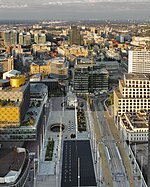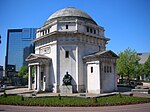Library of Birmingham

The Library of Birmingham is a public library in Birmingham, England. It is situated on the west side of the city centre at Centenary Square, beside the Birmingham Rep (to which it connects, and with which it shares some facilities) and Baskerville House. Upon opening on 3 September 2013, it replaced Birmingham Central Library. The library, which is estimated to have cost £188.8 million, is viewed by the Birmingham City Council as a flagship project for the city's redevelopment. It has been described as the largest public library in the United Kingdom, the largest public cultural space in Europe, and the largest regional library in Europe. 2,414,860 visitors came to the library in 2014 making it the 10th most popular visitor attraction in the UK.
Excerpt from the Wikipedia article Library of Birmingham (License: CC BY-SA 3.0, Authors, Images).Library of Birmingham
Broad Street, Birmingham Ladywood
Geographical coordinates (GPS) Address External links Nearby Places Show on map
Geographical coordinates (GPS)
| Latitude | Longitude |
|---|---|
| N 52.479722222222 ° | E -1.9083333333333 ° |
Address
Library of Birmingham
Broad Street
B1 2NR Birmingham, Ladywood
England, United Kingdom
Open on Google Maps










